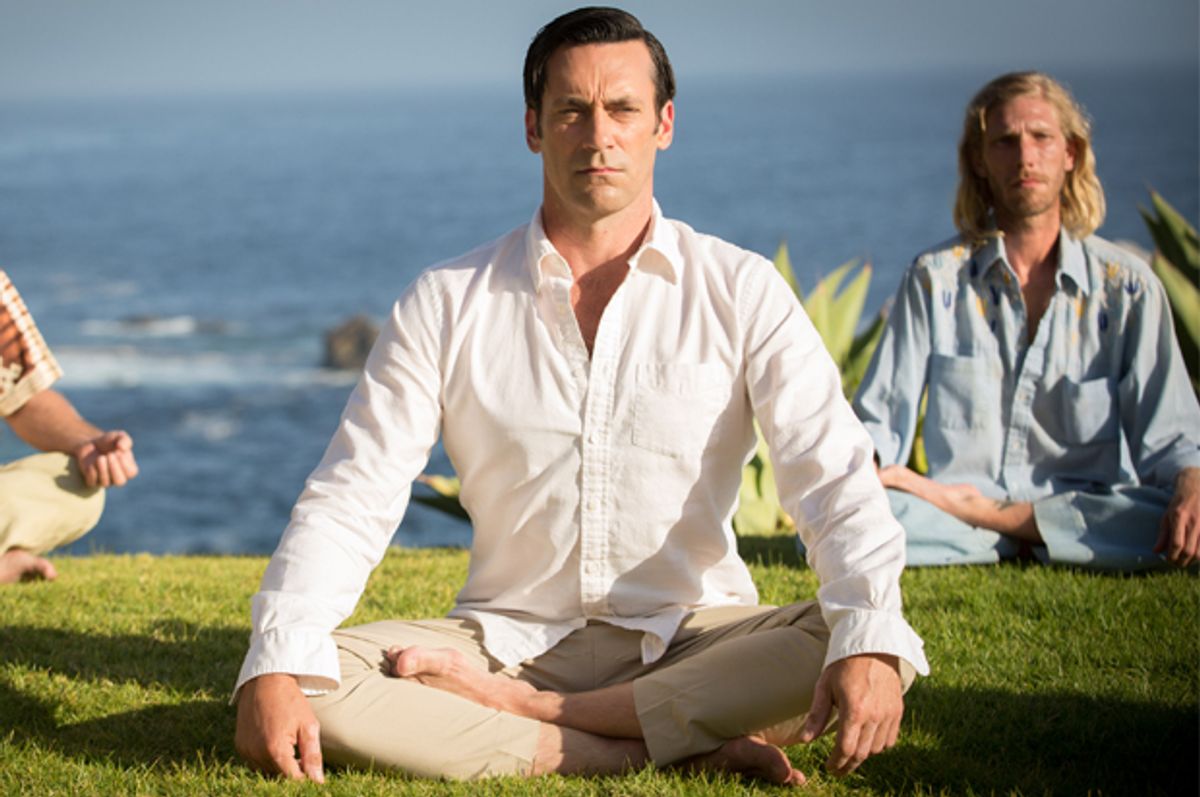If you live in California or know something about the nation’s most populous state, you get tired of the way Easterners and Brits caricature it. Yeah, yeah, Woody Allen’s right turn on red, OK, vegetarian restaurants, OK, dumb blondes, yeah, lame-ass New York Times story, OK … enough. But what’s a bit startling is when a smart show run by people based in California pull the same nonsense. That seems to be the way the Golden State works in “Mad Men,” which just concluded last night with a boatload of stereotypes.
Most of the show’s cast and crew – including creator Matt Weiner – live in or around Los Angeles, the part of California that has taken the brunt of misinformed condescension. But that hasn’t stopped them from misreading a very complex state, one that was becoming especially complex and various during the period over which the show travels.
California has been the capital of American – and, before that, European – dreaming for a long time. And television shows are not the same as history books. But the shallowness is still discouraging, especially coming from people who know better. We get something that resembles the old New Yorker cover "View of the World From Ninth Avenue."
Why is just about everyone in California Caucasian? (Even in the ‘60s New York scene we’d see a black secretary now and again.) Why is everyone falling into bed with real-estate agents? (Joan’s boyfriend Richard describes her as "undeveloped property”with “a hell of a view.") Why is everyone else some variation of hippie? Why does it always seem less like a real place than an Eastern fantasy? “Every time someone from Sterling Cooper and Partners winds up in California,” a Bustle story says, “it suddenly becomes their new ‘paradise.’” (It’s a place where even Pete can get laid.)
Why does Don always seem to be standing (often in his New York City business suit) next to a pool or the ocean? Harry Crane’s speech about “the Coast” could come from one of the weird fantasies Ronald Reagan maintained about the state he governed: “You don’t understand what it’s like out there. This failure? This life? It’ll all seem like it happened to someone else.”
Why does Megan seem to lose her mind (and her sexual mores) every time she’s out in L.A.?
But the real sign that Weiner and company may be having a go at us – layering the stereotypes on so thick that we’re supposed to know it’s a joke – is Pete Campbell. With his tennis whites, his big California dreams (“It’s filled with sunshine”), his iconic California sexual revelry and his trading of the bro-hug for the handshake, he’s the kind of newly arrived, trying-too-hard worm everyone out here knows.
Here’s a good assessment in EW:
The show initially used the West Coast for Don’s season 2 spirit quest, in “The Jet Set” and “The Mountain King.” “Jet Set” is one of the show’s weirdest episodes, and one of my favorites. It plunges right into the esteemed iconography of California-as-Sunsoaked-Dreamscape. Don meets a girl named Joy (!) who drives him out to the desert. He meets her family. They’re traveling Europeans, homeless, wealthy, vaguely incesty—well-dressed hobos. It’s a heaven of wish-fulfillment. (When Don has sex with Joy, she doesn’t just say the sex is good. She says it’s better than William Faulkner’s The Sound and the Fury.)
The latest and perhaps most obnoxious California dreaming takes place in the final episode, in what seems to be Esalen or another retreat where rich hippies get in touch with their feelings. There are a few nice moments, and the scenery is lovely. But it’s as pro-forma a look at Northern California as Don-by-the-swimming-pool was of the Southland. Do we have a weaselly, necklace-wearing guru who looks like he is preparing to deflower all the available women? (Check.) Group therapy and talk about sharing? (Check.) Manson reference? (Check.) Sun glinting off the ocean? (Check.) Hippie chick who tells us that what we all need is freedom, man? (Check.)
Of course, like many stereotypes, the familiar images of L.A. and the Big Sur coast come from somewhere. But there was an enormous amount of other stuff happening in California at the time, including the antiwar movement, the growth of Latino culture, an undeniably sophisticated old-money world in San Francisco and – perhaps most important – the persistence and even hardening of a rural and suburban conservative culture that gave us President Nixon and would, in brighter colors, bring on the Reagan revolution.
TV benefits from big, iconic gestures, and California functions in the show as a contrast to the life in New York. California really was, back then, partly about alternative lifestyles and family breakdown and the real-estate grab, as the detective novels of Ross Macdonald, the essays of Joan Didion and a number of other artists in various genres illustrate. But we don’t get that kind of insight when “Mad Men” goes to California. You’d sort of hope one of the most acclaimed shows of the last few decades might offer more depth than an Eagles song.

Shares